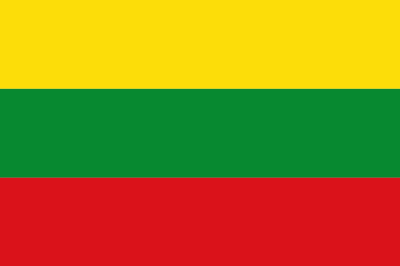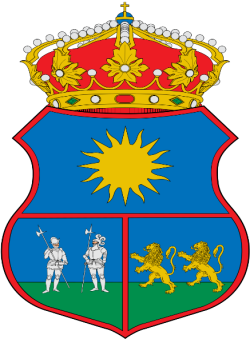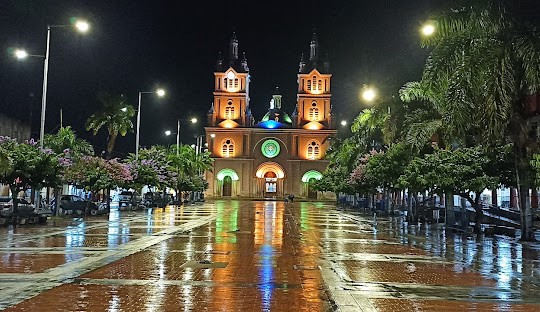GUADALAJARA DE BUGA
Department
Valle Del Cauca Department, Colombia

Flag of the city
The Flag of Buga, according to historians, is the same one that was flown in the Battle of Alto Palacé, carried by José María Cabal , the same one that the armies of Nariño swore on July 20 , 1813 , at the beginning of the southern campaign. The Flag of Buga is the same as that of the state of Cartagena in 1812, in which Atanasio Girardot died involved in the Cima de Bárbula. It is made up of three horizontal stripes whose colors are: the upper stripe in golden yellow, signifying the richness of its soil; The green middle stripe demonstrates the fertility of its land, and the lower red stripe symbolizes patriotism and the blood shed by the heroic sons of Buga, for the sake of Independence.

Seal of the city

Slogan of the city
“The Lady City” and “Spiritual Destination of America” appears to be a poetic and evocative tagline or descriptor for Guadalajara de Buga. This expression suggests a city that holds a special spiritual significance, perhaps due to its religious landmarks, cultural heritage, or historical importance. The term “Lady City” may refer to Buga’s feminine charm, grace, or perhaps a historical or religious association with a revered female figure. It adds a touch of elegance and character to the city’s identity. Describing Buga as a “Spiritual Destination of America” emphasizes its role as a significant center for spiritual and religious activities. This could be linked to the pilgrimage site, the Basilica of the Lord of the Miracles, reinforcing Buga’s reputation as a place of spiritual significance.
History

The history of Guadalajara de Buga is a tale woven through multiple foundations, migrations, and transformations, rendering it one of the oldest and most historically rich cities in Colombia. According to historical research, the city experienced four foundations at different locations and dates. The first foundation, whose date is still under investigation, was initiated by Governor Sebastián de Belalcázar, bearing the name Buga La Vieja. Subsequently, the second foundation occurred between 1554-1555, ordered by Pedro Fernández del Busto and executed by Giraldo Gil de Estupiñán, christened as Nueva Jerez de los Caballeros. The third foundation, orchestrated between 1557-1559 by Governor Luis de Guzmán and Rodrigo Díez de Fuenmayor, bestowed the name Guadalajara de Buga upon the city. Despite these efforts, the city underwent two more transfers, with the definitive one occurring in 1573 under the command of Governor Jerónimo de Silva and executed by Beltrán de Unzueta, securing the name Guadalajara de Buga at its present location. The city’s relocation was prompted by the “bugas,” indigenous warrior tribes who fiercely resisted Spanish conquest. The city’s present name is a homage to these formidable warriors. Over the centuries, Buga evolved, becoming the capital of the province between 1834 and 1887 and later organized as a municipality in 1908.
Buga played a pivotal role during the time of the conquest, contributing blood and patriotism during the Confederated Cities of Valle del Cauca in 1810. Recognized for its services to the crown, Buga was granted the title of City by King Felipe II of Spain in the late 16th century. Noteworthy historical events include the visit of the Liberator Simón Bolívar in 1822 and commemorative plaques marking his stay in 1829. The official acceptance of Buga’s foundation on March 4, 1570, marked the city’s definitive establishment. Elevated to the status of a municipality in 1884, Buga continues to carry its rich historical legacy, manifested in its landmarks, such as the Minor Basilica of the Lord of Miracles.
Geography of the city
Situated at the geographical coordinates of 3º 54′ 07″ north latitude and 76° 18′ 14″ west longitude, with reference to the Greenwich Meridian, the city unfolds its unique geography in a region marked by diverse elevations and natural features. The city’s terrain encompasses two distinctive zones — the Flat Zone, adjacent to the Cauca River, and the Mountainous Zone within the Central Mountain Range. The altitudes within its boundaries exhibit a significant range, spanning from 969 meters above sea level in the lowlands to an impressive 4,210 meters above sea level in the Páramo de las Hermosas, a high-altitude moorland. Buga’s borders are defined by natural landmarks and neighboring municipalities. To the north, it shares boundaries with the municipality of San Pedro, traced by the Quebrada Presidente along the rural perimeter, running from its source in the Central Mountain Range to its confluence with the Cauca River. It also adjoins the municipality of Tuluá, marked by the Tuluá River extending to its origin in the Páramo of Barragán within the Central Mountain Range. To the east, the city is demarcated by the high mountain range of the Central Mountain Range, delineated from the source of the Tuluá River to a point corresponding to the origin of the Sonso River. On the western frontier, Buga shares its limits with the rural perimeter of the municipality of Yotoco, tracing along the Cauca River from the estuary of the Sonso River to the Quebrada de Presidente. Finally, to the south, Buga’s boundaries connect with the municipalities of Ginebra and Cerrito, as well as the rural perimeter of Guacarí, following the course of the Sonso River from its origin in the Central Mountain Range to its convergence with the Cauca River.

Population
Total 128,945 inhabitants (2023)
Urban 112,305 inhabitants (2023)
One photo representative of the city

Etymology
The term “Buga” traces its origins to the Caribbean, as evidenced by its discovery in the Isthmus of Panama, where a town named Bugabá conveyed the meaning “place of the spear.” The etymology of Buga reflects its indigenous roots, resonating with the historical tapestry of the pre-Hispanic communities in the region. Guadalajara de Buga, the city founded by Spanish colonizers in the Central Mountain Range, carries a layered history within its name. The Spanish bestowed the name Guadalajara de Buga under the directive of Governor Don Luis de Guzmán, commemorating his homeland, Guadalajara in Spain. However, when Governor Don Álvaro de Mendoza Carvajal orchestrated the city’s relocation to Valle del Cauca, he rebranded it as Guadalajara de la Victoria. Despite this change, the original name, Buga, persevered and endured as the city’s primary identifier. The narratives surrounding the nomenclature of Buga underscore the dynamic interplay between indigenous names borne by pre-Hispanic communities and the designations imposed by Spanish conquerors during the conquest. Buga, emerging from the echoes of the Caribbean, stands as a testament to the evolving identity of a city shaped by the encounters, clashes, and amalgamation of cultures across centuries.
What the city is known or famous for

Guadalajara de Buga, one of Colombia’s oldest cities, holds a distinguished place on the cultural and religious map of the country. At its heart lies the Basilica of the Lord of Miracles, a revered pilgrimage site dedicated to the Señor de los Milagros (Lord of the Miracles). Pilgrims traverse the city from various corners of Colombia, seeking solace and miracles in this sacred space. The city’s historical narrative, rooted in its foundations dating back to the 16th century, unfolds through its well-preserved colonial architecture. Buga’s streets, adorned with charming plazas and cobblestone pathways, offer a journey into the past, showcasing its enduring cultural and architectural heritage. Buga is not only a city of historical significance but also a vibrant center of religious and cultural festivities. The Basilica’s festivals, marked by religious processions and vibrant celebrations, resonate with both locals and visitors, creating a lively and jubilant atmosphere. Simón Bolívar, the Liberator, left his mark on Buga with a visit on January 11, 1822. Commemorative plaques in the houses that hosted him serve as testaments to this historic event, further enriching Buga’s cultural tapestry. Beyond its religious and historical allure, Buga attracts tourists with its diverse landscapes. Nestled in the Valle del Cauca region, the city offers a mix of flatlands and mountainous areas, making it an enticing destination for nature enthusiasts. Buga is not merely a city; it’s a cultural haven where traditions are celebrated, local cuisine is savored, and the echoes of history reverberate through its streets. It stands as a testament to Colombia’s rich past and the ongoing interplay between spirituality, culture, and the allure of exploration.
